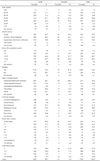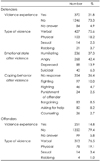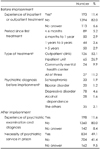Abstract
Objectives
The aim of this study was to identify mental health state of prisoners in correctional institutions and to develop strategies for improvement of the environment related to it.
Methods
This research included a total of 1700 inmates from three out of 50 prisons nationwide; Symptom Checklist-90-Revision (SCL-90-R), State-Trait Anger Expression Inventory, Beck Depression Inventory (BDI), the Korean Version of the Beck Scale for Suicide Ideation, and cut down, annoy, guilty, eye-opener were applied. Additional questionnaires were employed for investigation of inmates' experience of violence within the correctional facilities and to examine utilization of mental health service before and after their admission to correctional facilities.
Results
Fifteen percent of the participants attained SCL-90-R T-scores of 65 or higher, which suggested that these individuals had, or were at great risk of, mental illness. As the level of anger felt by the prisoners turned out to be lower than expected, BDI scores of 22 and higher were observed in 28.1% of the inmates, and 33.6% of the prisoners had suicidal ideation. In addition, 39.1% of the total inmates were diagnosed with alcohol abuse. Twenty-one percent of the prisoners were victimized in their correctional institutions; therefore, violence may be one of the potential factors leading to stress. However, only a small percentage of the inmates requested and received counseling as a help.
Figures and Tables
Table 2
Means and standard deviations (SDs) of SCL-90-R and proportions of prisoners with mental health problems in male and female prisoners

Table 4
Means and standard deviations (SDs) of BDI, K-BSI, and numbers of higher than cut-off scores in BDI and of suicide-related behaviors in K-BSI among prisoners

References
1. Ministry of Justice. Unpublished data. 2010.
2. Yang OK, Lee KY, Jhoo SH, Hyeon JH. Mental health and human rights survey on extremely vulnerable class. Seoul: National human rights commission;2008.
3. West HC, Sabol WJ. Prisoners in 2007. Washington, DC: Department of Justice, Office of Justice Program, Bureau of Justice Statistics;2008.
4. Blaauw E, Roesch R, Kerkhof A. Mental disorders in European prison systems. Arrangements for mentally disordered prisoners in the prison systems of 13 European countries. Int J Law Psychiatry. 2000; 23:649–663.
5. Boothby JL, Clements CB. A national survey of correctional psychologists. Crim Justice Behav. 2000; 27:716–732.

7. Link BG, Stueve A. Evidence bearing on mental illness as a possible cause of violent behavior. Epidemiol Rev. 1995; 17:172–181.

8. Lee SJ, Suh JH, Lee YH. Mental health status on the scores of MMPI among inmates of prisons. Korean J Psychol Gen. 2000; 19:43–62.
9. Lee CH, Rhee MK. Characteristics of personality and mental health in prison inmates. Korean J Soc Psychol. 2006; 20:77–90.
10. Bae DH, Shin SM. Mental health status and mental health service needs of women inmates in Korea. Korean J Woman Psychol. 2008; 13:479–497.

11. Nam YY, Lee HS, Oh KS, Kim DH, Lee JA. A study on developing a predicting model of suicidal behaviors and screening instrument in inmates. Gwacheon: Ministry of Justice;2007.
12. Cho EK. Necessity of correctional psychology. Correct Res. 2005; 27:13–25.
13. Derogatis LR. SCL-90 (Revised) Manual I. Clinical Psychometrics Research Unit. Baltmore: University School of Medicine;1977.
14. Kim KI, Kim JH, Won HT. Korean manual of symptom checklist-90-revision. Seoul: ChungAng Aptitude Publishing Co;1984.
15. Spielberger CD. Professional for the State-Trait Anger Expression Inventory (STAXI) (Research ED). Tampa, FL: Psychological Assessment Resources, Inc;1988.
16. Chon KK, Hahn DW, Lee CH, Spielberger CD. Korean adaptation of the state-trait anger expression inventory: anger and blood pressure. Korean J Health Psychol. 1997; 2:60–78.
17. Beck AT. Depression: Clinical, experimental, and theoretical aspects. New York: Harper & Row;1967.
18. Lee YH, Song JY. A study of the reliability and the validity of the BDI, SDS, and MMPI-D scales. Korean J Clin Psychol. 1991; 10:90–113.
19. Shin MS, Kim ZS, Park KB. The cut-off score for the Korean version of beck depression inventory. Korean J Clin Psychol. 1993; 12:71–81.
20. Beck AT, Steer RA, Ranieri WF. Scale for Suicide Ideation: psychometric properties of a self-report version. J Clin Psychol. 1988; 44:499–505.

21. Lee HS, Kwon JH. Validation for the Beck scale for suicide ideation with Korean university students. Korean J Psychol Gen. 2009; 28:1155–1172.

23. Mayfield D, McLeod G, Hall P. The CAGE questionnaire: validation of a new alcoholism screening instrument. Am J Psychiatry. 1974; 131:1121–1123.
24. Ryou YI. Performance of alcoholism screening instruments to detect at-risk drinkers in elderly male drinkers. Chungnam National University;2011.
25. Park BK, Lee DB, Lee TY, Cho YC, Kwon YH. Comparison of screening tests for alcoholism in terms of reliability, sensitivity and specificity. Chungnam Med J. 2000; 27:37–47.
26. Jeon BH, Noh H, Kim CW, Kim SE, Lee SJ, Lee DH. Does The drinking behavior of interns and residents affect their attitudes toward the Screening, Brief Intervention and Referral to Treatment (SBIRT) regarding alcohol? J Korean Soc Emerg Med. 2010; 21:495–503.
27. Jo MH. An evaluation of interpersonal psychological model of suicide in Korean army. Seoul: Korea University;2010.
28. Yoon OK. Types and prevalence of victimization among prison inmates. Correct Res. 2009; 45:223–251.




 PDF
PDF ePub
ePub Citation
Citation Print
Print






 XML Download
XML Download